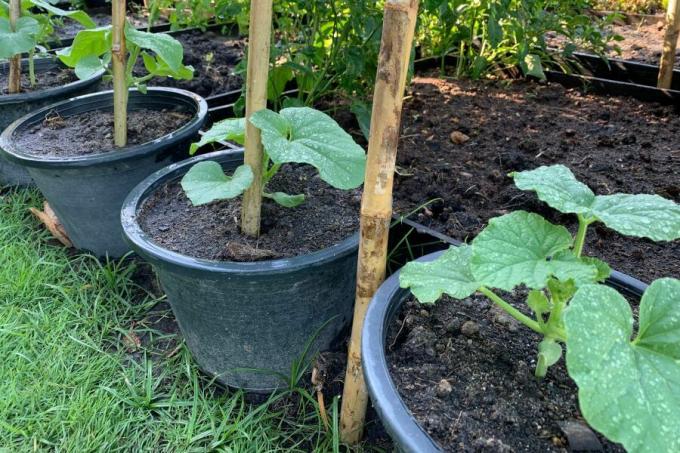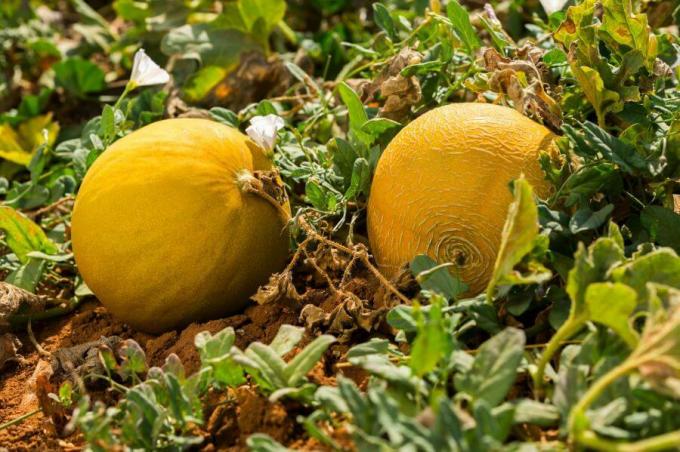The exotic honeydew melon can also be grown in our garden. We reveal what you have to consider when planting honeydew melons in beds and pots and give important tips on correct care.

Honeydew melons (Cucumis melo) are among the most sought-after refreshments of summer and are loved by many. But the sweet treats don't always have to come from the supermarket - in fact, the honeydew melon can also be wonderfully planted in your own garden or even on the balcony. We'll tell you here what you need to consider when planting honeydew melons and which varieties are particularly suitable for your own cultivation.
contents
-
Growing honeydew melon: the best varieties
- Honeydew melon varieties for the garden
- Honeydew melon varieties for the pot
-
Growing honeydew melons in the garden
- When to plant honeydew melons
- Plant honeydew melons in the bed
- Plant honeydew melons in a pot
- Care for honeydew melons after planting
Growing honeydew melon: the best varieties
Incorrectly be Melons often referred to as a fruit, it is a vegetable. From a botanical point of view, they actually belong to the cucurbit family (Cucurbitaceae) and are closely related to Cucumber (Cucumis sativus) and Pumpkins (Cucurbita) related. With well over 500 species, the melon occurs in numerous species, colors and variations. However, melons are divided into two groups: watermelons (Citrullus lanatus) and sugar melons (Cucumis melo) - The latter also includes the famous honeydew melon. Since the honeydew melon originally comes from the Mediterranean area, not all varieties are suitable for cultivation in Germany. However, there are more and more modern varieties that also thrive in the colder German climate. If you want to plant honeydew melons, you should therefore always make sure to choose varieties that can cope with the climatic conditions in this country.
Honeydew melon varieties for the garden
For cultivation in Germany, less cold-sensitive, robust varieties have proven themselves. The varieties of honeydew melons that are particularly suitable for planting in your own garden include, for example, the following:
‘Blenheim Orange’: Reliable yield even in poor climatic conditions; oval fruits up to 1 kg with fragrant, sweet pulp.
‘Petit gris de Rennes’: Matures well even in colder temperatures; small round fruits between 500 g and 700 g with orange, sweet pulp with a light caramel taste.
'Pineapple': Very cold-tolerant honeydew melon; oval, yellow to beige fruits with a net pattern and white, juicy-sweet flesh with a hint of pineapple.
"Sweet Granite": Very early melon variety, particularly suitable for regions with short summers and cool weather; orange-yellow fruits with a net pattern and sweet pulp.

Honeydew melon varieties for the pot
Planting honeydew melons is not difficult - in fact, you can even plant honeydew melons on the balcony if you can offer them a sunny spot. However, if you want to plant honeydew melons in a pot, choosing the right variety is essential. Some of the varieties that are suitable for growing in pots include:
"Minnesota Midget": Ideal beginner variety, which is suitable for growing in pots thanks to its low growth height of around 40 cm, bushy growth and short tendrils; early-ripening melon variety with only 60 days ripening time; high number of small, sweet fruits.
‘Ancien’: Tires well in the German climate thanks to the relatively short vegetation period; Plants do not need to be pruned; aromatic, sweet, but small fruits.

Growing honeydew melons in the garden
Growing honeydew melons in the garden sounds harder than it is. In fact, the annual plants can also be grown wonderfully in the garden if you pay attention to a few points when caring for them.
When to plant honeydew melons
Honeydew melons originally come from the Mediterranean area and accordingly need warm temperatures. It is therefore advisable to bring the melon plants forward in the house and first move the larger melon plants into the bed. The ideal time to start growing is early to mid-April. Depending on the variety, the honeydew melons can move to their new bed from mid-May. The seeds start to germinate particularly well if they are soaked in a thermos with lukewarm water for 24 to 48 hours beforehand. A classic potting soil - like the Plantura organic herb & seed compost - and growing pots are used. Only one seed should be used per pot. This is about two to three centimeters deep and should be moistened regularly with a spray bottle. The nursery pots should be set up in a bright and warm location with an average of 23 to 25 ° C, for example a sunny window sill. After eight to ten days, the seeds should then begin to germinate.
Tip: To mimic the climate of a greenhouse, you can stretch cling film over the pots. This keeps the soil and seeds moist. However, the foil should be opened daily so that fresh air can get to the seeds and mold does not develop.

The ideal time to plant honeydew melons:
- Sow indoors: mid to late April
- Seeds are preferred 4 to 6 weeks
- Preferably in a bright location at 23 - 25 ° C
- Plant out in the bed: Depending on the variety, from mid-May
Plant honeydew melons in the bed
As soon as there are no more frosts to be expected, you can plant the honeydew melons in the bed. The ice saints (i.e. mid-May) are usually mentioned as the reference date, as the danger of late frosts is over at this time. Two weeks before the seedlings are planted out, they should be given a serving of green fertilizer to strengthen them. Outside, the plant needs a sunny but sheltered place. However, young plants should not stand in the blazing midday sun at the beginning, as otherwise the sensitive leaves can quickly be burned. When choosing the right location, it is also important to ensure that there are no other plants from the pumpkin family nearby, in order to avoid cross-pollination - Also in the previous year no cucurbits should have stood at this point, otherwise the risk of diseases and reduced growth increases. Since honeydew melons are heavy eaters, they need a particularly nutrient-rich and humus-rich, but also loose soil. Legumes are therefore suitable as a good preculture, as they represent a natural green manure and also loosen the soil. These should be able to be warmed up quickly by the sun, but also have good water storage capacity. In addition, a slightly acidic pH is optimal to support the growth of the plants.

The distance between the individual young plants should be at least 80, but better still 100 Centimeters so that the plants have enough space later and not each other have to compete. It is also advisable to stretch a trellis or several cords for the plants so that they tend to climb upwards can - this not only improves the vitality of the plants, but the fruits can also be harvested more easily later will.
What is the perfect location for a honeydew melon?
- Sunny and sheltered from the wind
- Young plants must be shaded
- No other cucurbits in the preculture or as bed neighbors
- Well drained, nutrient-rich soil
- Slightly acidic pH
- Plant spacing: 80 - 100 cm
- Set up climbing aid
Plant honeydew melons in a pot
You don't need a huge garden if you want to grow honeydew melons. In fact, you can also plant honeydew melons in pots and thus cultivate them even in smaller gardens or on the balcony. A sufficiently large container with a volume of at least 25 liters, in which the plant can develop well, is crucial for successful cultivation. The plant can react very sensitively to later transplanting into larger containers, which is why you should plant the honeydew melon in a sufficiently large container from the start. When choosing a location, the same conditions apply as for the bed: The honeydew melon likes a sunny but sheltered location with loose and nutrient-rich soil. However, young plants should also be shaded initially, as they tend to burn quickly. Unlike in the bed, a honeydew melon planted in a pot has significantly less substrate available, which is why particular attention is paid to good quality and a sufficient concentration of nutrients in the soil should. To prevent waterlogging even when it rains, the pot for the honeydew melon should be provided with sufficiently large drainage holes. Depending on the variety, a climbing aid may also be necessary for honeydew melons on the balcony.
Tip: Note that the plant can develop tendrils of up to five meters. Depending on the variety, honeydew melons in the pot may not have enough space to unfold on a small balcony.

What does a honeydew melon need in the pot?
- Sufficiently large planter (at least 25 liters)
- Sunny, sheltered location
- Loose, nutrient-rich substrate
- Sufficiently large drainage holes
- Depending on the honeydew melon variety, climbing aid is required
Care for honeydew melons after planting
The planting is done: But how do you properly care for honeydew melons so that you can look forward to a rich harvest? Watering is most important - melons regularly need water to develop their large fruits. However, this should not be cold, as the temperature fluctuations can reduce the quality of the fruit: Regular watering with tempered water is therefore ideal. It should be poured in such a way that the soil is moistened to a depth of about 20 centimeters. But be careful: honeydew melons cannot tolerate waterlogging, which means that too much watering could be harmful. As soon as the fruit sets can be seen, watering should be done about every two to three days - even daily in particularly hot summers.
It is also important to ensure that the melon plants are optimally supplied with nutrients. This not only affects how well the plant and fruit grow, but also how well They can resist diseases and pests and affect the shelf life of the fruit the end. When planting, it makes sense to use a primarily organic long-term fertilizer like ours Plantura organic tomato fertilizer to use. This is particularly suitable because the honeydew melon, just like tomatoes, has an increased need for potassium. After 2 months, fertilize again, so that the plant is well supplied until the end of the year.
As a rule, the honeydew melons do not need a cut. If the honeydew melons are grown without a climbing aid, it is important to regularly remove budding weeds until the shoots of the melons completely cover the ground. Once the first fruits are finally formed, they should be placed on a surface such as straw, flower pots or wooden boards so that they are protected from moisture and rot.
In contrast to Cantaloupe - or net melons, ripe honeydew melons do not indicate the correct harvest time by their distinctive scent. Also that of Watermelons (Citrullus lanatus) known knock test does not give a clear statement about the maturity. In fact, it is not that easy to determine how ripe a honeydew melon is. The best way to tell when a honeydew melon is ripe is its skin: Depending on the variety, it should be brightly colored and smell pleasantly sweet. In addition, it yields to light pressure, but must not be too soft.

What do you have to consider when caring for honeydew melons?
- Regular watering with tempered water
- Fertilize with organic tomato fertilizer with a long-term effect
- No cut necessary
- Weed weeds regularly
- Place the fruits lying on the ground on a mat
Would you like to find out more about melons? We have everything you need to know about the different types of melons in our article "Melons: origin, types and diversity“Summarized for you.



